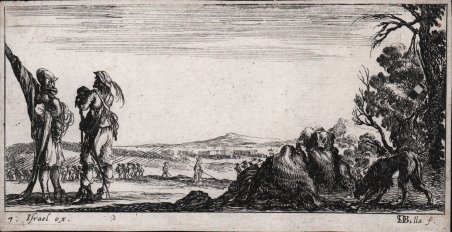A sinistra, due soldati in piedi che parlano, un cavallo morto a destra divorato da due lupi e un drappello di lancieri dietro a sinistra. Acquaforte, 1644 circa, con iscrizione nel margine sotto l'immagine con i dettagli della produzione: "SDBella f." e con l'indirizzo dell'editore: "Israel ex.". Dalla serie: Desseins de quelques conduites de troupes, Canons, et ataques de villes, pubblicata da Israël Henriet a Parigi. Serie di dodici stampe, tutte numerate a margine e alcune contrassegnate dall'indirizzo di Israel Henriet. Secondo De Vesme, a parte la lastra 2, l'intera serie potrebbe essere nel secondo o terzo stato, poiché differiscono solo in questa lastra. Bellisima prova, stampata su carta vergata coeva, margini sottili, in buone condizioni. Stefano della Bella fu uno degli incisori più interessanti e originali nella Firenze del XVII secolo e può considerarsi l’unico geniale continuatore dell’opera di Jacques Callot. La sua educazione artistica ebbe inizio a Firenze nella bottega degli orafi Gasparo Mola e Orazio Vanni, e la precisione del segno, tipica dell’arte orafa resterà caratteristica del suo stile. Studiò poi presso Giovanni Battista Vanni e forse anche presso il Cantagallina e Cesare Dandini, ma ben presto si dedicò all'incisione. Il suo vero maestro può considerarsi Jacques Callot, l’incisore francese che soggiornò a lungo a Firenze lasciando una forte impronta nel panorama artistico della città. Gli anni più importanti della sua carriera sono quelli che trascorre a Parigi, dal 1639 al 1650, stipendiato da Lorenzo de' Medici: lavorò insieme ad Israel Silvestre, con gli editori Langlois, Ciartres e Pierre Mariette, per stampatori francesi e per commissioni di gran prestigio, come quelle del 1641 per il cardinale Richelieu che gli affidò le illustrazioni delle sue imprese guerresche. Intorno al 1647, durante un viaggio in Olanda, dove eseguì le acqueforti con le vedute del porto di Amsterdam, incontrò Rembrandt e da quella data notiamo una eco profonda dell’arte dell’olandese nella grafica del Della Bella. Bibliografia De Vesme - Massar Stefano della Bella (1971) n. 252 II/III. At left, two soldiers standing talking, a dead horse at right being devoured by two wolves and a troop of lancers behind to left. Etching, circa 1644, lettered in margin below image with production detail: "SDBella f." and with publisher's address: "Israel ex.". From the series: ' Desseins de quelques conduites de troupes, Canons, et ataques de villes, published by Israël Henriet in Paris. Series of twelve prints, all numbered in the margin and some marked with Israel Henriet's address. According to De Vesme, apart from plate 2, the whole series may be in the second or third state as they only differ in this plate. Beautiful proof, printed on contemporary laid paper, thin margins, in good condition. Stefano della Bella was one of the most interesting and original engravers in 17th-century Florence and can be considered the only brilliant continuator of Jacques Callot's work. His artistic education began in Florence in the workshop of the goldsmiths Gasparo Mola and Orazio Vanni, and the precision of sign, typical of the goldsmith's art, will remain characteristic of his style. He then studied under Giovanni Battista Vanni and perhaps also under Cantagallina and Cesare Dandini, but soon turned to engraving. His real master can be considered Jacques Callot, the French engraver who stayed in Florence for a long time and left a strong imprint on the city's artistic scene. The most important years of his career were the ones he spent in Paris, from 1639 to 1650, salaried by Lorenzo de' Medici: he worked together with Israel Silvestre, with the publishers Langlois, Ciartres and Pierre Mariette, for French printers and for commissions of great prestige, such as those of 1641 for Cardinal Richelieu, who entrusted him with illustrations of his warlike exploits. Around 1647, during a trip to Holland, where he executed etchings with views of the port of Amsterdam, he met Rembrandt, and from that date we note a profound echo of the Dutchman's art in Della Bella's graphic work. Bibliografia De Vesme - Massar Stefano della Bella (1971) n. 252 II/III. Cfr.

Découvrez comment utiliser
Découvrez comment utiliser

